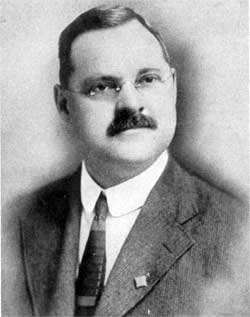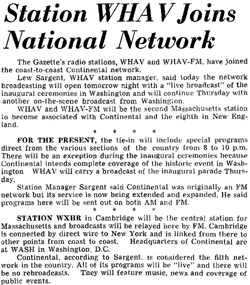By Tim Coco
WHAV President & General Manager (volunteer)

Greenleaf Whittier Pickard
Last month, in part 1, we discussed the theory about how any one person is only six introductions away from any other and found immediate local connections between FM radio inventor Edwin Howard Armstrong, two sisters from Merrimac, Mass. and famous local son John Greenleaf Whittier.
The sisters, Esther Marion and Marjorie McInnes grew up in Merrimac and went to work for the then-new Radio Corporation of America (RCA). While there, Marion met Major Armstrong, who became RCA’s largest stockholder when he sold the company several of his radio patents.
In Part 2, we learn of Armstrong’s connections to Greenleaf Whittier Pickard and WHAV.
Pickard, the only son of Whittier’s niece Elizabeth H. and Samuel T. Pickard, was born in Portland, Maine, Feb. 14, 1877. Pickard’s valuable contributions to radio were often overshadowed by his famous grand uncle’s accomplishments.
Pickard flunked out of the Lawrence Scientific School at Harvard University—where he had been given a special opportunity to attend since his grand uncle had been a trustee there, but later took classes at Massachusetts Institute of Technology. He had taken an interest in wireless telegraph inventor Guglielmo Marconi’s work and found an opportunity in 1898 at the Blue Hill Observatory, Milton, Mass. The Observatory was commissioned by the Smithsonian Institute to conduct experiments with kites to determine how height affected transmission of radio waves.
Pickard next went to work as research engineer for the newly formed American Wireless Telephone and Telegraph Co., Philadelphia, and helped establish a station in Cape May, N.J. It was here, on May 22, 1902, his first of many great radio contributions was made. He accidentally laid fine sewing needles lightly across a pair of carbon blocks and found he could receive radio transmissions without an external power source.
“Being exasperated by the microscopic ‘fry’ of my detector, I attempted to check the annoyance by cutting out two of the three dry cells. The signals continued to come in, weaker, but clear. Suddenly, to my utter amazement, as I glanced over the apparatus I discovered that I had cut out not two but all three dry cells! My telephone diaphragm was being operated solely by the energy received on the aerial! Nobody believed at that time that such a thing was possible,” Pickard was reported as saying.
As a result, Greenleaf patented his first of many inventions—the silicon crystal detector—in 1906. “The cat’s whisker” remains the heart of radio receivers to this day.
Between 1902 and 1906, the American Telephone and Telegraph Company (AT&T) recruited Pickard to help develop a wireless telephone. At the company’s Boston offices, Pickard reportedly sent the first-ever transmission of voice by radio on Sept. 2, 1902. He also apparently moonlighted as a consultant, performing services in 1904 for Lee DeForest, the inventor of the Audion vacuum tube amplifier.
Pickard, who had since moved into the poet’s former Amesbury home to the chagrin of the Whittier Home Association, which had leased the home as a memorial, continued his radio experiments there. In 1907, along with Col. John Firth and patent attorney Philip Farnsworth, Pickard founded the Wireless Specialty Apparatus Co. of Boston. It began by selling the Perikon (PERfect pIcKard cONtact) branded crystal. Interestingly, Pickard’s Seabrook, N.H. summer home, purchased in 1912, would be named “Perikon Cottage.”
The Wireless Specialty Apparatus Co. became the premiere supplier of radio receiving sets to the U.S. Navy until 1914. It also handled the sales of transmitters by the National Electric Signaling Co. (NESCO). NESCO’s scientific director was Reginald Aubrey Fessenden, the man credited with sending the first transmission of voice by radio from Brant Rock, Mass. in 1906.
In 1912 Firth sold his majority shares in the Wireless Specialty Apparatus Co. to United Fruit Co., which later consolidated its radio patents within RCA. Pickard continued to consult for RCA into the 1930s.
Pickard and Armstrong
Pickard became the second president of the Institute of Radio Engineers in 1913—about the same time Major Edwin Howard Armstrong was filing his regenerative circuit patent that would be disputed by DeForest. Years later, Pickard received his first major recognition of his work from the Institute, accepting in 1926 the Institute’s Medal of Honor, given “to that person who has made public the greatest advance in the science or art of radio communication, regardless of the time of performance or publication of the work on which the award is based.” Other winners included Armstrong, 1918; Ernst F. W. Alexanderson, 1919; Marconi, 1920; Fessenden, 1921; and DeForest, 1922.
Pickard and Armstrong would become better acquainted during meetings of the Radio Club of America, founded in 1909. During December, 1935, the club created the Armstrong Medal to initially honor Armstrong and then be presented to those “within its membership who shall have made in the opinion of the Board of Directors and within the spirit of the club, an important contribution to the Radio Art and Science.” Armstrong served as toastmaster when the medal was presented to Pickard in 1940.
The Pickards still summered at Perikon Cottage, Seabrook, and resided there year round during the depression. The Seabrook home and surrounding land remain occupied by his descendants to this day. Even though the Armstrongs spent summers in nearby Rye Beach, John B. Pickard said during a recent telephone interview, the families did not become close socially.
A professional relationship, however, between Pickard and Armstrong remained in place. After the latter’s invention of FM, Pickard was retained to study the effects of the Federal Communications Commission’s (FCC’s) planned move of the FM radio band. Pickard’s work proved Armstrong’s contention the proposal defied scientific research. The FCC moved the band anyway in a decision that critics said had more to do with slowing Armstrong than promoting good engineering.
Pickard also was one of the first to note the effects of major meteor showers on radio reception in 1921 and wrote in favor of the formation of the Federal Radio Commission in 1927 to regulate broadcasting.
During World War II, he worked on military projects for the American Jewels Corp., Attleboro, Mass. In 1946, he joined with Harold S. Burns to form the research and development firm Pickard & Burns, Inc. of Needham, Mass.
Despite his radio work and relative lack of interest in his grand uncle’s legacy, Pickard accepted, perhaps grudgingly, his election as a trustee of Haverhill’s Whittier Birthplace in 1916. He filled the seat vacated by his father’s death in 1915 and went on to serve as president of the board from 1938 to 1940. During his presidency, he arranged to have Whittier’s Dec. 17 birthday celebrated with a nationwide radio broadcast from the birthplace with Ted Malone, a newscaster also known for reading poetry on his “Between the Bookends” radio show. Pickard, although he attended few meetings, served as a trustee for 40 years.
The inventor passed away Jan. 8, 1956 at age 78. His firm had developed a solid reputation as manufacturer of submarine antennas, nuclear reactor temperature monitors and antenna coupling equipment. It was purchased by the Gorham Corp. in 1960, LTV Corp. in 1964 and Cardwell Condenser Co. in 1970. Cardwell Condenser exists today as Viking Technologies Ltd. Burns left the firm in 1962.
Armstrong, The Continental Network and WHAV

WHAV joins Continental Network announcemengt.
WHAV originally planned to launch an FM station at 46.5 megahertz before even considering an AM station. The FCC’s 1945 decision, however, to move the FM band—largely to stifle Armstrong’s invention of wideband FM—made all existing FM radios obsolete.
“Indications are at present that engineering development on FM will continue for some time, not being as far advanced as had been generally believed,” WHAV founder John T. “Jack” Russ said in early 1946, explaining the delay in Haverhill finally having its own radio station.
WHAV-FM finally launched April 14, 1948—a year after its fall back AM station—and joined the Continental FM Network at the beginning of 1949. It was the second Massachusetts station to affiliate and the eighth in New England.
The Continental FM Network was first unveiled by Armstrong at the 1947 convention of the National Association of Broadcasters (NAB). Continental was headed by Everett L Dillard, owner of WASH-FM, but largely funded by Armstrong. Rather than rely on low-quality telephone lines to move programs across the network, each station picked up programs off the air from another FM station in the chain. Where telephone circuits were still necessary to connect stations, Armstrong underwrote the cost of expensive high-fidelity circuits.
Unfortunately, the artificially delayed development of FM—aimed at discouraging Armstrong by requiring manufacturing of FM receiving sets for the new band and retooling of transmitters—greatly harmed WHAV’s finances. WHAV-FM was out of business by 1953 and its transmitter was sold to WCRB.
The following year, when Armstrong killed himself, his funds stopped flowing to the Continental FM Network and it also closed.
Sources:
Pickard, J.B. (2009). Whittier’s idiosyncratic relatives. Amesbury, Mass.: Michaelmas Press.
Leonard, J. W. (1922). Who’s who in engineering. New York: Leonard Corporation.
Hibbert, S.K. (1922, September). An untold romance of invention. Popular Science, 31 and 90.
Proc, J. (2012). Omega. Retrieved from http://www.jproc.ca/hyperbolic/omega.html
